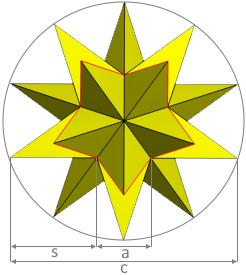Great Stellated Dodecahedron Calculator
Online calculator and formulas for calculating a great stellated dodecahedron
Great Stellated Dodecahedron Calculator
The Great Stellated Dodecahedron
A great stellated dodecahedron is the most complex Kepler-Poinsot polyhedron with twelve extended pentagonal star faces.
Great Stellated Dodecahedron Properties
The ultimate star polyhedron: Twelve pentagonal stars extended to their maximum
|
|
What is a Great Stellated Dodecahedron?
A great stellated dodecahedron represents the ultimate achievement in star polyhedra:
- Definition: Maximum stellation of the dodecahedron
- Classification: Fourth Kepler-Poinsot polyhedron
- Faces: Twelve extremely extended pentagonal stars
- Vertices: 20 vertices (shared with icosahedron)
- Nature: Highly self-intersecting
- Dual: Great icosahedron
Geometric Properties of the Great Stellated Dodecahedron
The great stellated dodecahedron displays the most extreme stellar characteristics:
Ultimate Stellar Parameters
- Faces: 12 maximally extended pentagonal stars
- Edges: 30 edges
- Vertices: 20 vertices
- Stellation: Maximum possible extension
Extreme Properties
- Maximum stellation: Furthest possible extension
- Star density: Highest among Kepler-Poinsot solids
- Self-intersection: Most complex intersection patterns
- Golden ratio: All relationships involve φ
Mathematical Relationships
The great stellated dodecahedron follows the most complex mathematical laws:
Maximum Golden Ratio
All formulas involve the golden ratio. Maximum complexity achieved.
Ultimate Star Geometry
Each star extended to maximum length. Creates the most complex patterns.
Applications of the Great Stellated Dodecahedron
Great stellated dodecahedra find applications in advanced fields:
Advanced Mathematics
- Polyhedral group theory
- Stellation research
- Topology studies
- Golden ratio applications
Art & Sculpture
- Complex sculptural works
- Geometric art installations
- Mathematical art
- 3D visualization projects
Research & Education
- Advanced geometry research
- Polyhedral studies
- Mathematical modeling
- Stellation theory
Computer Science
- Advanced 3D algorithms
- Computational geometry
- Mathematical visualization
- Complex surface rendering
Great Stellated Dodecahedron Formulas
Edge length (s)
Edge length with golden ratio
Chord length (c)
Chord connecting star vertices
Volume (V)
Volume with complex golden ratio factor
Surface area (S)
Extremely large surface area due to stellation
Circumference Radius (r)
Radius of circumscribed sphere
Height (h)
Height from center to star point
Example calculation for a Great Stellated Dodecahedron
Given
Calculate: All properties of the great stellated dodecahedron
1. Edge length calculation
The edge length is 16.18 units
2. Chord length calculation
The chord length is 42.36 units
3. Volume calculation
The volume is 6545 cubic units
4. Surface area calculation
The surface area is 4616 square units
Summary
Complete analysis of the maximally stellated dodecahedron with side length 10
The Great Stellated Dodecahedron: Pinnacle of Stellar Geometry
The great stellated dodecahedron represents the absolute pinnacle of stellar polyhedral geometry. As the fourth and final Kepler-Poinsot polyhedron, it achieves maximum stellation - the furthest possible extension of the dodecahedron's faces into space. This creates a structure of unparalleled complexity and mathematical beauty, where twelve pentagonal stars reach their ultimate dimensional limits, creating the most intricate self-intersecting patterns possible in regular star polyhedra.
The Ultimate Achievement in Stellation
The great stellated dodecahedron showcases maximum stellar complexity:
- Maximum stellation: Faces extended to their absolute limits
- Ultimate golden ratio: Most complex φ relationships
- Extreme self-intersection: Most intricate crossing patterns
- Final Kepler-Poinsot: Completion of the stellar quartet
- Dual complexity: Dual to the great icosahedron
- Icosahedral vertices: Shares vertex structure with icosahedron
- Mathematical climax: Peak of polyhedral sophistication
Historical and Mathematical Pinnacle
Kepler's Final Discovery
The great stellated dodecahedron completed Kepler's quartet of star polyhedra, representing the ultimate achievement in extending regular polyhedra beyond convex boundaries.
Maximum Golden Ratio
This polyhedron exhibits the most complex relationships involving the golden ratio, pushing the mathematical beauty of φ to its absolute limits in three-dimensional form.
Ultimate Complexity
With the largest surface area and most extreme proportions among the Kepler-Poinsot solids, it represents the mathematical boundary of regular stellar geometry.
Artistic Supremacy
Its maximum stellation creates the most dramatic and visually striking patterns, making it the ultimate expression of mathematical art in polyhedral form.
Conclusion
The great stellated dodecahedron stands as the crowning achievement of stellar polyhedral geometry, representing the absolute limits of what is possible when extending regular faces into star configurations. Its maximum stellation creates a structure of breathtaking complexity and mathematical elegance, where every dimension pushes the boundaries of the golden ratio's influence. As the final member of the Kepler-Poinsot quartet, it completes humanity's exploration of regular star polyhedra, achieving a level of geometric sophistication that serves as both a mathematical terminus and an artistic masterpiece. For students of advanced geometry, it represents the ultimate challenge and reward - a shape that embodies the highest achievements of mathematical thought while displaying the infinite beauty possible within rigorous geometric constraints. The great stellated dodecahedron truly is the pinnacle of stellar geometry.
|
|
|
|
Tetrahedron • Cube • Octahedron • Dodecahedron • Icosahedron
